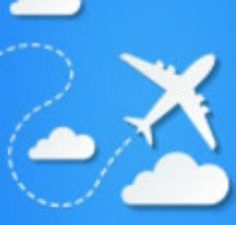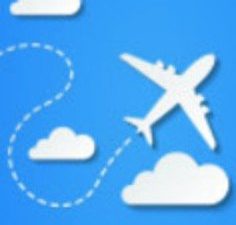Smoother Air
December 31, 2017

In the pre-deregulation era before 1978, the Civil Aeronautics Board told airlines when, where and how often they could fly. “Interlining” with another carrier was about the only way airlines could extend their reach beyond their own carefully-circumscribed route structure. Passengers could fly, say, on Eastern Airlines between Miami and Dallas by first catching Eastern up to Atlanta and then transferring to Delta for the remaining leg to Dallas. Their bags would tag along.
Simple enough.
Fast-forward to AD2017. Eastern is gone with the wind and Delta’s route map, when you throw in code shares and SkyTeam alliance connections, resembles a series of clustered starbursts covering the globe.
Today’s airline relationships only start with interlining. Then comes codesharing, a juiced up species of interlining which often includes airline club access and the ability to earn and burn frequent flier miles.
Then there’s the straight equity purchase by one airline of a stake in another. The percentage of that purchase is often limited by foreign and US federal laws.
Joint ventures comes next in the hierarchy. They allow airlines to set seat capacity and fares on certain routes, oft-times on which the two were competitors. JV’s are often subject to regulatory OK by the US Department of Transportation and the Department of Justice. Joint ventures are currently the relationship du jour.
Finally there’s the alliance. It’s “just an amalgamation of codesharing arrangements involving codeshare arrangements among like-thinking carriers,” says Robert W. Mann, president of R.W. Mann & Company, a suburban New York-based aviation consultancy.
Further complicating this air carrier layer cake are the swirls and exception-laden language that renders one relationship not wholly like the other.
There’s news emanating from each kind of relationship, news that could influence the way business travel is booked and bought. There’s one fundamental thing to remember however: “All of these are beards [disguises] for what the carriers really want: freedom of establishment in a country and elimination of ownership and control,” says Mann.
Here, in descending order of importance, is a rundown of what’s new in each arena:
Joint Ventures
Delta and SkyTeam alliance partner Korean Air are taking their relationship one step further. The two carriers recently signed a memorandum of understanding to implement a joint venture agreement.
The aim is to create a fully integrated transpacific JV. That means DL and KE will share costs and revenues on flights, as well as coordinate schedules for “seamless” connections. The deal isn’t done till the regulators approve it.
Like unto the Korean/Delta deal is a Joint Cooperation Agreement between Delta and Aeromexico. The JCA allows the two airlines to operate transborder flights between the United States and Mexico.
The significance from the business traveler’s perspective? According to Delta’s news hub the two carriers “will work together to enhance their customer experience on the ground and in the air by investing in airport facilities, boarding gates and lounges.”
Delta and Aeromexico have a long history of working together. They launched their first codeshare together back in 1994. Now there’s a concrete buy-in. Delta owns just over one-third (36.2 percent to be precise) of Grupo Aeromexico.
Equity Purchase
One airline buying a stake in another is another dance step in the airline do-si-do; but it gets really interesting when it becomes a when it becomes a pas de trois. Delta Air Lines, Air France-KLM and Virgin Atlantic have taken steps toward combining their partnerships into a single joint venture. As part of the arrangement, Delta is investing €375 (about $440 million) to acquire 10 percent of Air France-KLM.
At the same time, Air France-KLM will acquire Virgin Group’s 31 percent stake in Virgin Atlantic; Delta already has a 49 percent stake in Virgin Atlantic. Ultimately, the deals would bring the two pre-existing joint ventures – Air France-KLM, Delta and Alitalia; and secondly Delta and Virgin Atlantic – within a single joint venture. Details are pending and the deal is subject to regulatory approval.
American Airlines committed to make a $200 million equity investment in China’s largest carrier, China Southern Airlines. This paves the way for a “long-term” relationship between the two.
Interestingly, China Southern is a member of the SkyTeam alliance, while American is a founding member the oneworld alliance.
The percentage of American’s investment into China Southern is limited. It can’t do a true JV with the Guangzhou-based carrier. “The [US Department of Transportation] will only permit joint ventures, and in particular anti-trust immunity with joint ventures, when there’s an open skies arrangement between the US and the country involved,” says Mann. To date, China doesn’t have an open skies agreement with the US.
So what’s the advantage not just for American but for its customers? Mann says it offers them a “front row seat” to the world’s hottest aviation market.
“Right now for American Airlines the buy-in doesn’t do anything,” asserts Mike Boyd, president of Boyd Group International, a major airline consultancy. But after Beijing’s new Daxing Airport is open, it should create exciting new possibilities for American. “Looking down the line they’re making good sense,” says Boyd.
Codesharing
From the onset, the prime pitch of airline alliances has been “seamless service.” While there’s been progress, there’s still a way to go before seamlessness goes systemwide.
“Any of the carriers nowadays will tell you that it’s seamless service. The problem is sometimes the ‘seamless service’ seems like the Berlin Wall back before it fell,” says Mann. “It’s very difficult to access some of the same services you’d expect from your native carrier on the codeshare or the alliance carrier.”
The airline consultant and former American Airlines executive offers a case in point. “For a long time it was impossible to get an advance boarding pass on British Airways, even though it was sold as part of a BA/AA joint itinerary. You literally had to stand by as if you were a non-rev (non-paying passenger) at the counter when you arrived at London Heathrow. This is for a business class itinerary.”
It’s just such disconnects that bring business travelers’ blood to a fast boil. Alliances realize that and are trying – stitch-by-stitch – to fashion a legitimately “seamless” product. They’re not there yet, but there is some notable progress of late.
The largest and oldest alliance, Star, just turned twenty years old. In a prepared release touting the event, Star says it’s shifting focus from network expansion “to providing a seamless experience, especially to the over 14 million annual customers who connect between member carriers on their journeys.”
From now on out, says Star, “digital technologies will lie at the heart of this strategy.”
Over the past quarter of a century, getting airlines’ IT systems to talk with one another has been a persistent problem. Information silos have been slow to fall. It’s getting the back office data ready for prime time that’s driven chief information officers crazy. Now, asserts Star, there’s better integration of back-end services between the member airlines. “With this now in place, we can start building and offering digital applications.”
A couple of examples: When stuff hits the fan and your feeder flight is delayed, the connecting boarding pass information can now be accessed by the airline operating that feed. This means faster and simpler re-booking. Heretofore that kind of transaction meant the feeder carrier picking up the phone and calling the connecting carrier.
One of the irksome irritants of accruing frequent flier points is that they sometimes evaporate into cyberspace. Alliances are weaving remedies to the problem. Late last year SkyTeam rolled out an online, retroactive credit tool that renders it easier for frequent fliers to keep tabs on their account balances and make sure they’re up to date. The tool is available across most of the SkyTeam’s alliance. “Uncredited flights can make a difference when it comes to a customer’s status level or being able to claim an award ticket,” says Michael Schutzbank, SkyTeam’s director for customer loyalty.
The striving for seamlessness extends to booking and buying tickets as well. Oneworld alliance says it’s launched a program called oneworld Explorer aimed at making multi-airline, multi-sector fares easier. In a prepared release oneworld says travel agents connected to the Sabre GDS and its associated Abacus and INFINI systems “can book and automatically calculate the fare for these tickets, complete with taxes and other charges.” The result is an “instant price for the entire journey.”
Creature Comforts
Cleaning up the digital domain is critical, but building out brick and mortar facilities is important too. Today more than ever, it’s critical to move through the airport fast. With that in mind, Star has launched a new Connection Service at Chicago O’Hare International Airport to assist their customers in reaching their onward flight with another Star Alliance member carrier. The service activates if an incoming flight happens to be delayed.
Software monitors the transfer window for customers with an onward flight and flags any cases where a customer and any checked bags appear at risk of missing a connection. For arriving international flights, the service is designed to whisk both customers and their bags through customs and immigration clearance. Star says the service is set to be rolled out to 11 airports around the world.
To ramp up connecting convenience, alliances began clustering ticket kiosks and baggage check-in devices around member airlines’ counters. Fast-track access for alliance elites and co-location of airport lounges is also picking up momentum.
Los Angeles International Airport is the locus of Star’s co-located lounge in the TBIT (for the uninitiated, that’s the Tom Bradley International Terminal). All Star carriers flying out of LAX are represented in the new lounge. The enclave is away from the madding crowd. You’ll find it on aisle C, at the north end of the TBIT. On days when the smog allows, the 18,000 square-foot affair serves up knockout views of the Hollywood Hills. To refresh the body there’s an octet of showers rooms; to sooth the soul there’s a library.
Star’s got a new lounge in Rio too. You’ll find it on the third level of Rio de Janeiro’s Galeão-Jobim International Airport. The 6,500-square-foot-plus set-up seats some 150 passengers. Like LAX, the views can be stunning. In this case Rio’s iconic landmarks – Sugar Loaf and Christ the Redeemer – are visible in the distance. This being Brazil, the new lounge comes replete with premium barista coffee.
All eyes may be focused on Beijing’s late decade opening of Daxing Airport, but the present airport, Capital International, remains an important cog in the Asian aviation wheel. To that end, SkyTeam has opened a new 8,600-square-foot, 160-seat getaway. It serves the dozen SkyTeam carriers flying into PEK. The view of the airport may not rival new lounges in Rio and Los Angeles, but the sunlight (when it’s able to penetrate the haze) is a welcome relief. The new Beijing facility offers shower rooms, a relaxation area, and hot and cold buffet.
The alliance game has changed. Once each promoted their breadth, just how large they were, how many destinations with how many flights. After the dance partners were chosen it came time to refine the steps, to better choreograph the intricate movement of people, flying machines and data across barriers that defined a pre-deregulation era. In the process, some fliers toes were stepped on.
Now the planet’s three marquee alliances – Star, SkyTeam and oneworld – are addressing what matters most to business travelers: the no-surprise flow of fellow fliers, their baggage and their beloved frequent flier points across the globe.
Loosen your seatbelt a bit; the ride’s getting more seamless by the mile.




